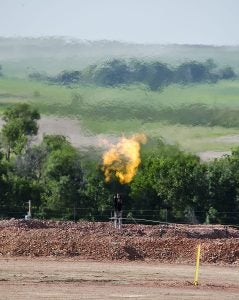North Dakota has a flaring problem that even industry recognizes
 Last year, oil and gas companies in North Dakota flared over $220 million worth of natural gas. That’s enough to heat over 1 million homes and meet North Dakotans’ heating needs seven times over.* It was also enough to convince the North Dakota Petroleum Council (NDPC), an industry coalition, to reconvene its flaring task force.
Last year, oil and gas companies in North Dakota flared over $220 million worth of natural gas. That’s enough to heat over 1 million homes and meet North Dakotans’ heating needs seven times over.* It was also enough to convince the North Dakota Petroleum Council (NDPC), an industry coalition, to reconvene its flaring task force.
The irony is that North Dakota already has flaring reduction targets on the books. They were created in 2014, at a time when the state was wasting one-third of the natural gas it produced. These rules set a series of gas capture targets, which were proposed by NDPC, and gave the state the authority to curtail the oil production of operators that failed to meet those targets. But since the rule’s implementation, North Dakota operators have allowed nearly $850 million of natural gas to go up in smoke.*
So why aren’t North Dakota’s flaring restrictions consistently working?
The problem is that the North Dakota Industrial Commission (NDIC) catered to industry and created plenty of carve-outs and exceptions to its rules. For starters, the state’s policy sets gas capture goals as a percentage of gas produced, instead of volumetric limits. As a result, operators can increase the amount of gas they flare as they increase oil production without running afoul of the capture requirements. Moreover, operators can avoid curtailment by showing that other wells they operate in the same field, county, or state, are flaring at lower levels.
Finally, the NDIC has shown reluctance to curtail oil production even in cases where violations of the gas capture goals are clear. For example, last October, 11 companies failed to meet flaring targets and none of them faced production limits thanks to the state’s porous policies.
[Tweet “North Dakota has a flaring problem that even industry recognizes”]
NDPC’s reconvened task force is reviewing ways to improve companies’ gas capture plans, but given the massive amount of flaring and industry’s inability to meet flaring targets so far, the state should look to stronger enforcement standards. If most operators that flare excessive amounts of gas are exempted from production limits, the state’s targets have no real enforcement mechanism and aren’t worth the paper they’re printed on. Industry ought to comply with the targets it helped draft, and the NDIC should hold those who don’t comply accountable.
The state could have looked to BLM’s waste prevention rule to stem the waste of natural gas on tribal and public lands, but federal rollbacks make it seem unlikely North Dakota will see the benefits of that rule. That’s deeply troubling given the flaring problem on tribal lands in North Dakota and the lost revenue this means to tribal communities like those on the Fort Berthold Indian Reservation.
North Dakotans deserve more than a pyrrhic victory on flaring reduction; they deserve real results from enforceable and effective rules to protect their state’s resources, air quality, and economic interests.
*These figures were calculated using flaring volumes reported by the North Dakota Industrial Commission and residential consumption data from the Energy Information Administration.











